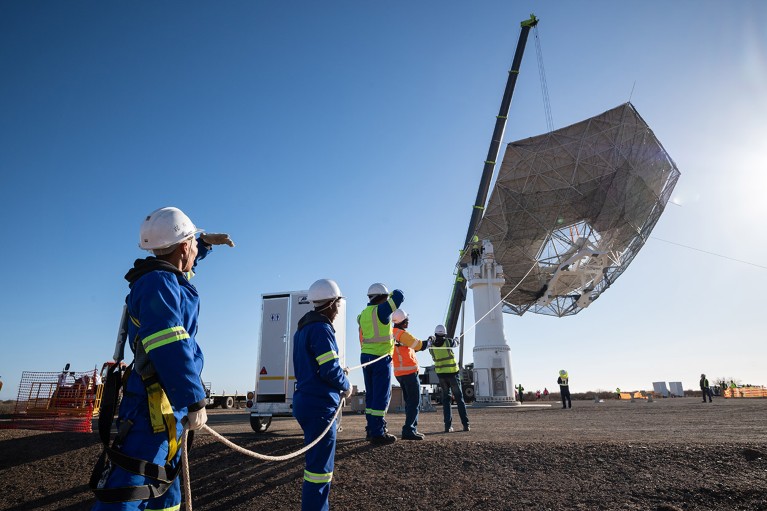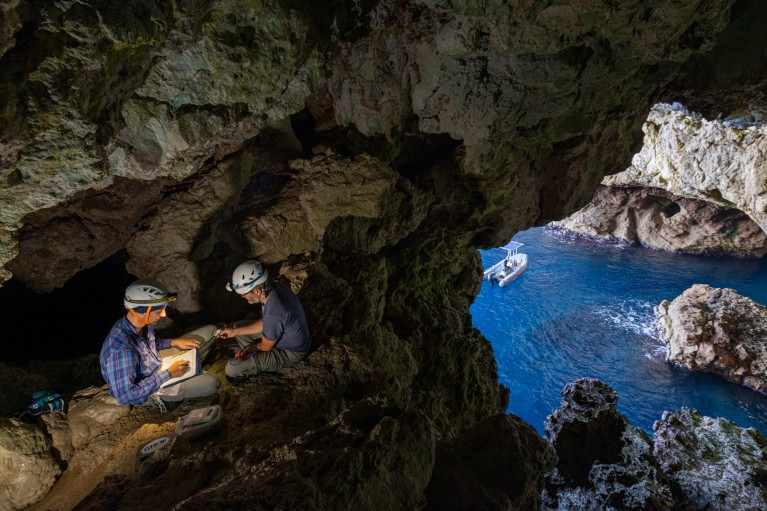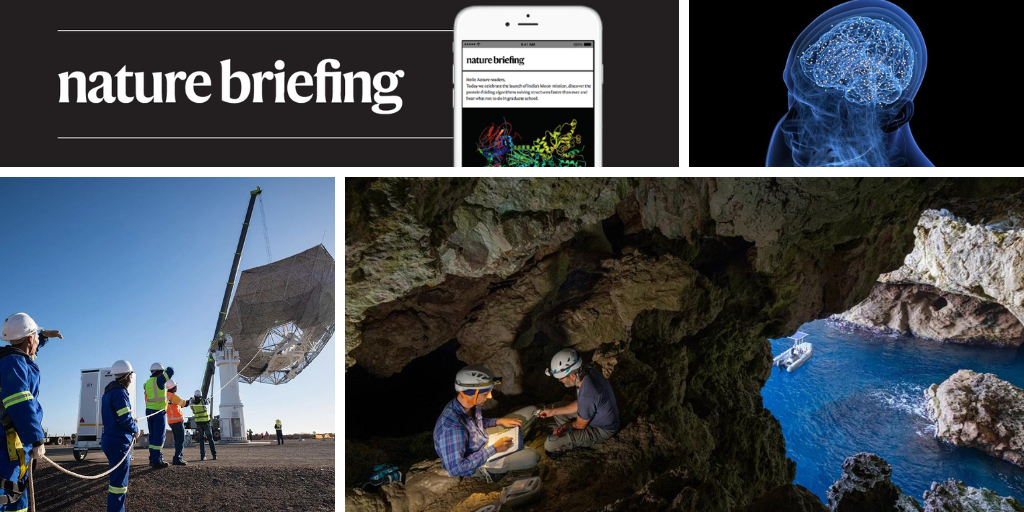Hello Nature readers, would you like to get this Briefing in your inbox free every day? Sign up here.

The big lift: Engineers in South Africa participate as a crane lifts an SKA telescope reflector onto its pedestal (pictured in July).Credit: SKAO (CC BY 3.0)
The expansion of the Square Kilometre Array (SKA), the world’s largest radio telescope, into eight more African countries won’t be sticking to its original timeline. A funding crunch has pivoted the project from a large expansion to “more of a phased, continual deployment”, says SKA director-general Philip Diamond. However, the expansion won’t stop fully. Botswana, one of the eight partner countries, will get its first SKA dish next year.
Some researchers in Venezuela fear that science in the country is “going down the drain”. The country’s economy has been in crisis and national science funding is proportionally smaller than in comparable countries, leaving research institutions and universities struggling to stay open. Young scientists have left in droves seeking out high-quality education or stable career prospects. And an ‘anti-NGO’ law now requires non-governmental organizations to share information about their funding with the Venezuelan government. Researchers, who sometimes look to NGOs for support, worry that this gives the government discretion to prosecute anyone whose motives it does not agree with.
A livestock breeder in Montana will be sentenced for cloning endangered Marco Polo sheep (Ovis ammon polii) in what a US federal attorney described as “an audacious scheme to create massive hybrid sheep species to be sold and hunted as trophies”. The act of cloning itself wasn’t the problem — but various laws limit trade in endangered species, the importation of certain sheep into Montana and trade in wild-sheep parts in the state. The breeder’s lawyer defended his achievement as “an extraordinary animal, born of science, and from a man who, if he could re-write history, would have left the challenge of cloning a Marco Polo only to the imagination of Michael Crichton”.
The Associated Press | 4 min read
Features & opinion
Behind the scenes of a groundbreaking drug
Last week, the first schizophrenia medication in decades with a new mechanism of action won US regulatory approval. The drug, KarXT (sold as Cobenfy), targets proteins in the brain known as muscarinic receptors, which relay neurotransmitter signals between neurons and other cells. Activating these receptors dampens the release of the chemical dopamine, a nervous-system messenger that is central to the symptoms of schizophrenia.
The approval is an example of what molecular pharmacologist Andrew Tobin calls “an emerging golden age of muscarinic drug development”. The area has its roots in antiquity, he notes: ancient Egyptians treated airway disease by breathing the smoke from a herb containing a muscarinic receptor antagonist. Now, with a better understanding of the receptor’s biology and advances in drug design, these medications offer promise for other hard-to-treat neurological diseases, including Alzheimer’s disease.
Nature | 6 min read & Nature Reviews Drug Discovery | 57 min read
In the latest Nature Careers advice column, a PhD student asks how to manage nerves and sensory overload when presenting a poster at a busy conference. One idea is to prepare a short and long version of your poster presentation in advance. Practise it a few times — seven is the magic number, says linguist and conference-maestro Mark Freiermuth. And don’t underestimate the toll the task can take on you. “If you’re someone who has an introvert energy, it might be better for you to sleep in that day or take a break for two hours in the afternoon to regroup,” says ADHD-coaching expert Laurie Dupar.
Do you have a work dilemma you’d like some help with? E-mail [email protected]
Albert Einstein’s concept of space-time as the fundamental fabric of reality is one of the most fruitful and successful scientific ideas of all time. It’s also not the end of the story — or at least, physicists sense that it might not be. Join the ambitious quest to discover the true nature of reality with Quanta’s delightfully interactive interviews, essays and video. Start at the beginning or skip straight to a visualization of three thought experiments that space-time can’t explain.
Quanta | Special issue including interactive infographic
Where I work

Federico De Pascalis is a researcher at the Institute for Environmental Protection and Research.Credit: Bruno D’Amicis & Andrea Benvenuti
In caves on Foradada Island, near Sardinia, Federico De Pascalis and his colleagues fit nesting European storm petrels (Hydrobates pelagicus) with tiny GPS loggers to determine their range and use that knowledge to find ways to protect them from pollution. “They have a history of myth and mystery,” he says. “In nineteenth-century folklore, seafarers believed them to be the spirits of dead sailors, who brought storms to ships. In reality, the birds were seeking shelter near the boats in bad weather. Having a deeper understanding of them makes them even more special.” (Nature | 3 min read)
On Friday, Leif Penguinson’s weekly hiding place was in the stunning Augrabies Falls in Northern Cape Province of South Africa. When you’re ready, here’s the solution showing exactly where in the area Leif was lingering.
Thanks for reading,
Flora Graham, senior editor, Nature Briefing
With contributions by Jacob Smith
Want more? Sign up to our other free Nature Briefing newsletters:
• Nature Briefing: Careers — insights, advice and award-winning journalism to help you optimize your working life
• Nature Briefing: Microbiology — the most abundant living entities on our planet — microorganisms — and the role they play in health, the environment and food systems.
• Nature Briefing: Anthropocene — climate change, biodiversity, sustainability and geoengineering
• Nature Briefing: AI & Robotics — 100% written by humans, of course
• Nature Briefing: Cancer — a weekly newsletter written with cancer researchers in mind
• Nature Briefing: Translational Research — covers biotechnology, drug discovery and pharma


